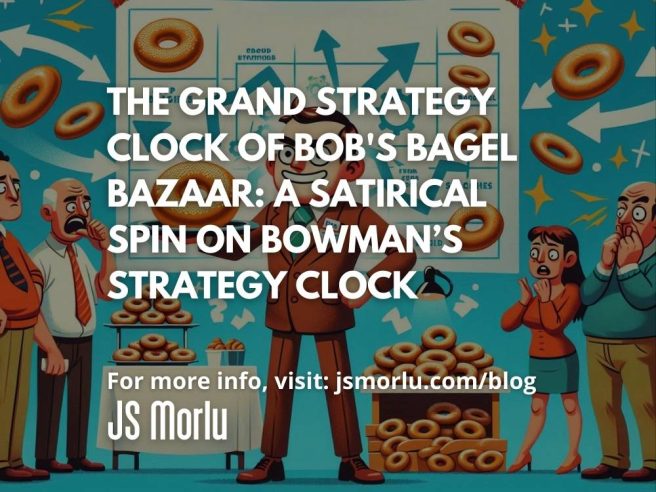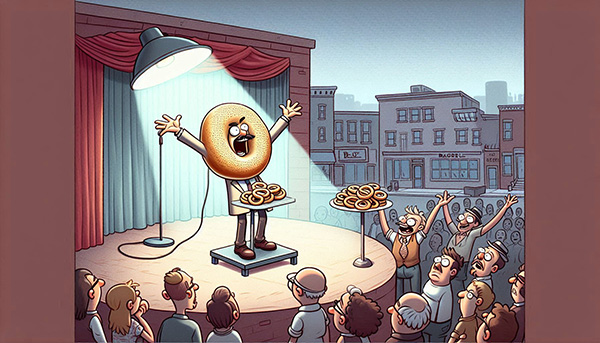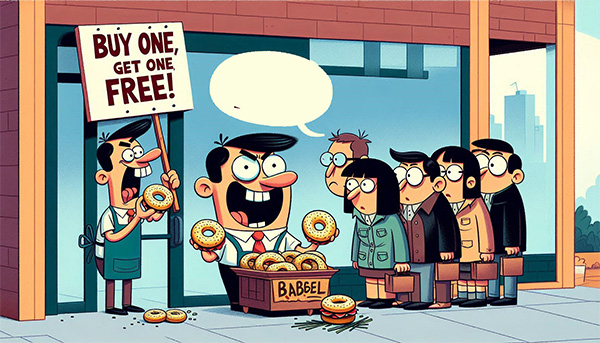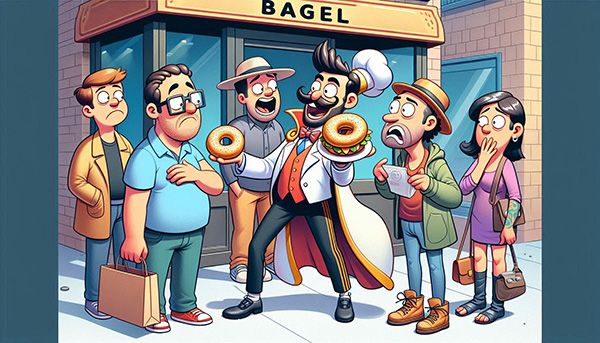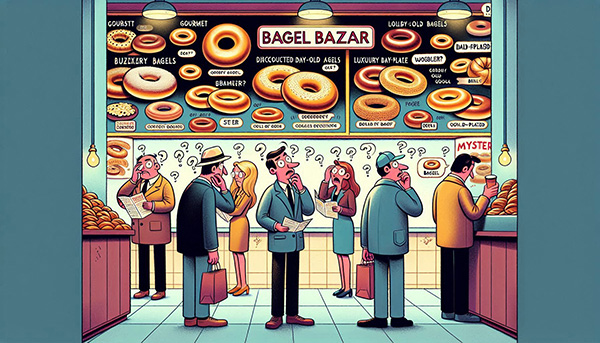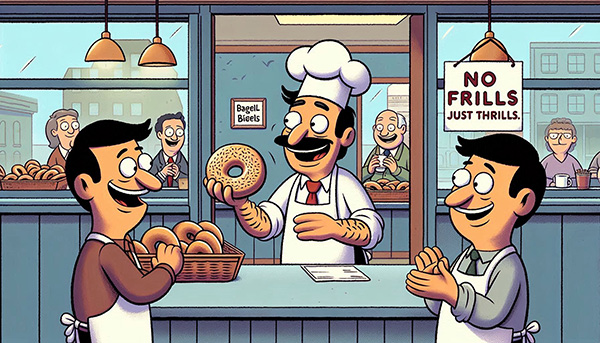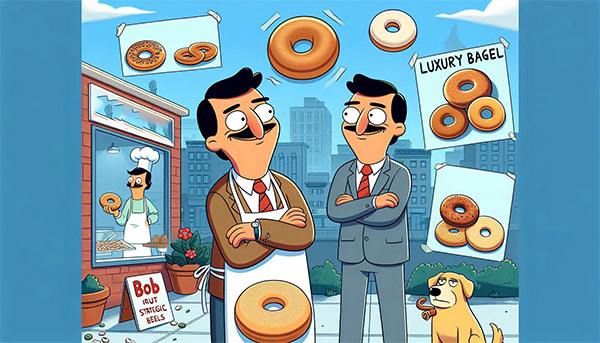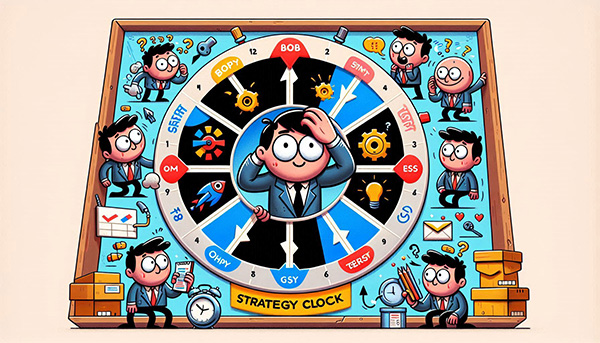By: John S. Morlu II, CPA
Introduction
In the quirky universe of small business, where every entrepreneur dreams of turning their passion into profit, few tools hold as much mystique—or as much potential for comedic mishap—as Bowman’s Strategy Clock. Designed by Cliff Bowman in the 1990s, this sophisticated framework promises to guide businesses through the murky waters of competitive advantage by plotting their position based on price and perceived value. It’s a beacon for those who seek to understand their market positioning and outmaneuver their competitors. However, when this meticulously crafted tool lands in the hands of Bob, the well-meaning but strategically clueless owner of Bob’s Bagel Bazaar, it transforms into a grand spectacle of business blunders.
Bob’s Bagel Bazaar, nestled in a sleepy suburban town, is not your average bagel shop. Here, grandiose plans meet everyday realities with hilariously disastrous results. Bob’s attempts to apply Bowman’s Strategy Clock lead to a series of bumbling strategies, from his ill-fated “Low Price, Low Value” bagels to the over-the-top “Gold-Plated Bagel” fiasco. Each move is a testament to Bob’s endearing optimism and remarkable ability to turn high hopes into laughable reality. As Bob tries to position his bagels in various strategic quadrants, his well-intentioned plans often devolve into farcical situations that entertain and bewilder both his customers and himself.
Prepare for a rollercoaster of bagel blunders and strategic shenanigans as Bob’s Bagel Bazaar embarks on a comedic journey through Bowman’s Strategy Clock. This is not just a tale of a small business struggling with strategy; it’s a full-blown adventure where bagels become the punchline in a series of strategic missteps. From misguided luxury to confused customer service, Bob’s escapades offer a humorous and insightful look at the pitfalls of overcomplicating business strategy. So grab a cup of coffee, enjoy a fresh bagel (hopefully), and get ready to laugh at the delightful chaos that ensues when strategic theory meets real-world absurdity.
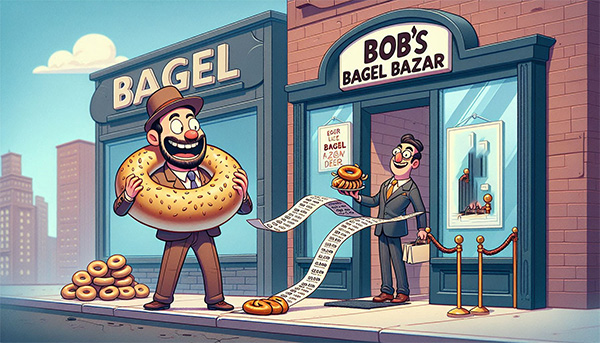
Chapter 1: The Grandiose Entry: Bob’s Bagels vs. The Bagel Empire
Let’s set the stage: Bob’s Bagel Bazaar, founded by Bob, a man with more enthusiasm than business acumen, finds itself in the shadow of The Bagel Empire, a competitor known for its “Lox-and-Luxury” bagels. These bagels are so overpriced, they come with a complimentary therapy session for your wallet. Bob, ever the optimist, decides to apply Bowman’s Strategy Clock to outsmart them.
Bob’s strategy? Position himself in the “Low Price, Low Value” quadrant. His bagels are priced at $1.50 each, which is cheaper than a cup of coffee, but his marketing is pure gold. Bob proudly announces, “Our bagels are affordable, just like your old gym membership!” The town’s response? A puzzled look, followed by a collective shrug and a noticeable uptick in bagel-related sarcasm.
Chapter 2: The “Gourmet” Gimmick: Bob’s Grand Plan for Differentiation
Bob, in his infinite wisdom, decides to spice things up with a “Gourmet Bagel of the Month.” This bagel features a “secret blend of spices,” which Bob insists is as ancient as the pyramids. The reality? It’s garlic powder mixed with oregano. The grand unveiling is marked by a bizarre event featuring local performers who juggle bagels with all the grace of a clumsy octopus.
Despite Bob’s high hopes, the gourmet bagel’s debut is a flop. The spice blend proves so unremarkable that even Bob’s dog turns up its nose. Bob’s excuse? “Our gourmet bagels are so exclusive, even the spices are too sophisticated for common taste buds.” The town’s new favorite pastime becomes trying to figure out if Bob’s gourmet bagel is an elaborate prank.
Chapter 3: The “Bagel Bonanza”: A Deal Gone Wrong
Determined to shake things up, Bob launches a “Bagel Bonanza” deal: buy one bagel for $2, get the second one free. It sounds like a great deal until you realize that the “free” bagel is just a day-old leftover dressed up with fresh chives. The deal attracts throngs of bargain hunters who are swiftly disillusioned when they bite into a bagel that’s as fresh as yesterday’s news.
Bob’s rationale? “We’re not just selling bagels; we’re offering a taste of nostalgia, with a side of savvy savings!” The townspeople begin to joke that Bob’s Bagel Bazaar is the only place where “buy one, get one free” translates to “pay for one, get two mediocre bagels.”
Chapter 4: The “Gold-Plated Bagel”: A Lesson in Luxury
In an act of strategic brilliance (or perhaps a mid-life crisis), Bob introduces the “Gold-Plated Bagel,” priced at a staggering $25 each. The bagel is adorned with edible gold leaf, which Bob markets as a symbol of opulence. Unfortunately, the gold leaf does nothing to enhance the flavor of the bagel, which remains as plain as ever.
The locals are bemused. One customer quips, “I wanted a bagel, not a golden crown for my mouth.” Bob’s explanation? “The gold represents the golden age of bagels!” The ultimate lesson: no amount of gold leaf can mask a mediocre bagel, and the only thing shining brighter than the gold is Bob’s persistent optimism.
Chapter 5: The “Stuck in the Middle” Meltdown: A Strategic Identity Crisis
Bob’s Bagel Bazaar finds itself in the dreaded “Stuck in the Middle” quadrant of Bowman’s Clock. Bob’s attempt to cater to everyone results in a menu that’s as confusing as a Rubik’s Cube. He offers everything from gourmet bagels to day-old deals, creating a hodgepodge of options that leaves customers bewildered.
The shop’s new motto becomes: “We’ve got something for everyone, but probably nothing you actually want.” The staff, overworked and underwhelmed, start referring to the shop as “Bob’s Bagel Bermuda Triangle,” where customers enter with high hopes and leave with a sense of deep confusion.
Chapter 6: The “Eureka” Moment: Bob’s Return to Simplicity
After countless failed strategies and a comedy of errors, Bob has a revelation. Instead of obsessing over Bowman’s Clock, he decides to return to basics: making reliable, tasty bagels at a fair price. Bob’s Bagel Bazaar refocuses on simplicity and authenticity, offering consistently good bagels without the bells and whistles.
Bob’s new slogan becomes, “The Bagel Bazaar: No Frills, Just Thrills.” The community embraces the new approach, and Bob’s shop becomes a local favorite, proving that sometimes the ultimate strategy is to keep things straightforward. Bob’s Bagel Bazaar is reborn as a place where the bagels are delicious, the deals are genuine, and the only gimmick is the occasional free smile from Bob himself.
Chapter 7: Conclusion-The Absurdity of Overcomplicating Strategy
Bowman’s Strategy Clock, a beacon of strategic wisdom for seasoned experts, can take on a delightfully absurd life of its own when applied to a small business with a penchant for theatrical blunders. In the case of Bob’s Bagel Bazaar, the sophisticated framework becomes the backdrop for a comedy of errors where theory meets its match in the whimsical world of bagel-making. Bob’s journey through the strategic quadrants is a testament to how even the most well-intentioned strategies can spiral into delightful farce when not tempered with practical sense.
Through his various strategic escapades, from the misguided “Low Price, Low Value” offerings to the extravagant “Gold-Plated Bagel” debacle, Bob’s Bagel Bazaar demonstrates that the true essence of successful business strategy lies not in adhering strictly to theoretical models but in genuinely understanding and responding to customer needs. While Bob may not have nailed the intricate dance of the Strategy Clock, he has unquestionably mastered the art of turning every strategic stumble into an opportunity for community engagement and laughter.
In the end, Bob’s Bagel Bazaar may not have achieved strategic perfection, but it has become a cherished local institution, proving that the best business strategies are those grounded in authenticity and a good sense of humor. So, let’s raise a toast to Bob and his bagel shop, where every strategic misstep is met with a hearty laugh and a reminder that sometimes, the most memorable success stories are those that embrace their own delightful absurdity.
Chapter 8: Background and Explanation of Bowman’s Strategy Clock
Bowman’s Strategy Clock is a strategic management tool developed by Cliff Bowman in the 1990s, designed to help businesses analyze their competitive position in the marketplace. This model plots a company’s competitive position based on two dimensions: price and perceived value. The goal is to identify how a business’s offerings align with customer expectations and how it can achieve a competitive advantage.
The clock is divided into eight distinct strategic positions, each representing a different combination of price and value:
1. Low Price, Low Value: This strategy involves offering products or services at a low price, but with minimal perceived value. It is often associated with budget or discount brands that compete primarily on cost.
2. Low Price: Here, the focus is on providing a low price while maintaining a higher perceived value compared to the “Low Price, Low Value” position. This strategy aims to attract cost-conscious customers who still seek a reasonable quality.
3. Hybrid: This position aims to offer a balanced mix of low prices and moderate value. Companies using this strategy seek to appeal to a broad market by providing a decent quality product at a competitive price.
4. Differentiation: In this quadrant, businesses provide a high perceived value but at a higher price. The strategy focuses on distinguishing the product through unique features, quality, or branding, appealing to customers who are willing to pay a premium.
5. Focused Differentiation: This involves offering exceptional value at a very high price. It targets niche markets that are willing to pay top dollar for premium products or services.
6. Increased Price, Standard Value: This strategy involves raising prices while maintaining the same level of value. It’s often a risky move that can lead to a loss of customers if the perceived value does not justify the higher price.
7. High Price, Low Value: This is a detrimental position where a company charges high prices for products or services that customers perceive as having low value. This strategy is typically unsustainable and can lead to a loss of market share.
8. Low Value, High Price: Similar to the “High Price, Low Value” position, this strategy is often a recipe for failure, as it involves offering poor value at a high price point, leading to customer dissatisfaction and reduced sales.
Bowman’s Strategy Clock offers a valuable framework for businesses to assess their market position and refine their strategies to align with customer expectations and competitive dynamics. By exploring these strategic positions, companies can gain insights into their market perception and uncover opportunities for differentiation, cost leadership, or enhanced value delivery. However, as demonstrated by Bob, small business owners can sometimes apply the model in ways that lead to comical and unintended results.
Author: John S. Morlu II, CPA is the CEO and Chief Strategist of JS Morlu, leads a globally recognized public accounting and management consultancy firm. Under his visionary leadership, JS Morlu has become a pioneer in developing cutting-edge technologies across B2B, B2C, P2P, and B2G verticals. The firm’s groundbreaking innovations include AI-powered reconciliation software (ReckSoft.com) and advanced cloud accounting solutions (FinovatePro.com), setting new industry standards for efficiency, accuracy, and technological excellence.
JS Morlu LLC is a top-tier accounting firm based in Woodbridge, Virginia, with a team of highly experienced and qualified CPAs and business advisors. We are dedicated to providing comprehensive accounting, tax, and business advisory services to clients throughout the Washington, D.C. Metro Area and the surrounding regions. With over a decade of experience, we have cultivated a deep understanding of our clients’ needs and aspirations. We recognize that our clients seek more than just value-added accounting services; they seek a trusted partner who can guide them towards achieving their business goals and personal financial well-being.
Talk to us || What our clients says about us

